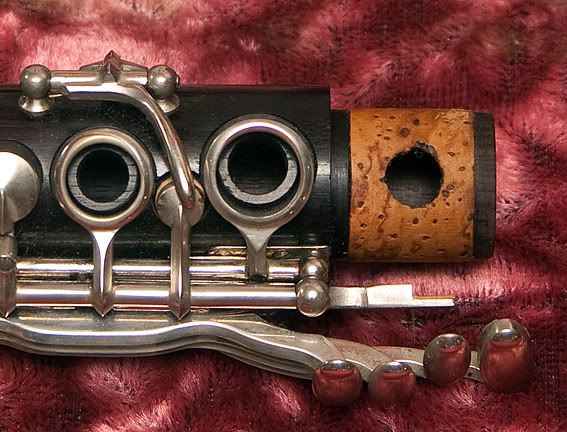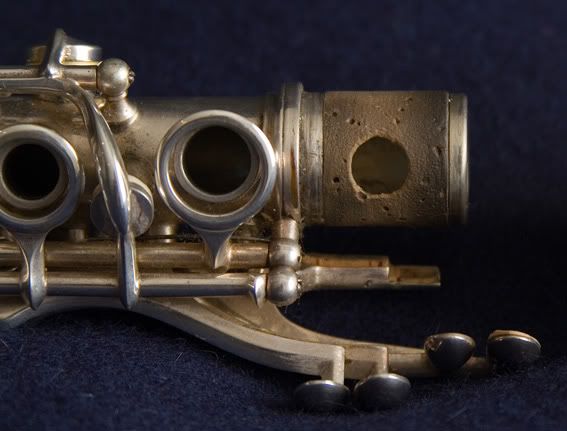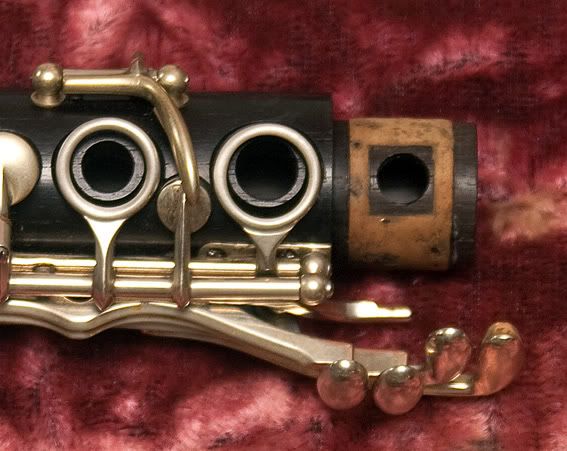 The Clarinet BBoard The Clarinet BBoard
|
Author: grenadilla428
Date: 2011-08-28 02:04
Hi, all,
I very recently saw a 1930's Buffet A clarinet up for auction, and it had a very neatly cut hole through the top joint tenon.
Ideas why?
|
|
Reply To Message
|
|
Author: SteveG_CT
Date: 2011-08-28 03:13
Didn't we just have a thread on this a couple of days ago? At any rate, there is a tonehole in the tenon because the instrument has an articulated C#/G#. I have a Selmer CT with the same configuration.
edit: Looks like the previous thread may have been deleted since it referenced an active auction.
Post Edited (2011-08-28 03:14)
|
|
Reply To Message
|
|
Author: sfalexi
Date: 2011-08-29 03:28
Articulated G# keys are cool. I wish more clarinets came with it. Standard on saxes, but apparantly special order for clarinets. And it makes trills easier, and the lower C# SO much clearer. Sigh. I'll never understand why clarinet makers (clarinetists?) resist things that make playing easier! lol.
Alexi
Retired, playing more sax than clarinet, but still playing clarinet and still loving it!
|
|
Reply To Message
|
|
Author: Katrina
Date: 2011-08-29 03:48
I like the articulate C# fine but I really really use my "full F" fingering in the altissimo way too much to want to play my full Boehm all the time...That and the whole "learning another instrument's intonational tendencies" thing...
|
|
Reply To Message
|
|
Author: clarnibass
Date: 2011-08-29 08:40
>> Articulated G# keys are cool. <<
Yes, but it disables too many fingerings I use, so prefer not to have it.
|
|
Reply To Message
|
|
Author: Chris P
Date: 2011-08-29 09:43
While you lose the full fingering altissimo F with an articulated C#/G#, you can still use a full fingering for altissimo Bb by playing upper register C but with the thumb off the thumb tube but still opening the speaker key instead of opening the C#/G# (which you can't as the RH rings keep it closed).
My other favourite device hardly ever fitted to new instruments from the big name makers anymore is the forked Eb/Bb mechanism (the 7th ring for LH3) so Eb or Bb can be played as xox|ooo - and unlike long Bb (xoo|xoo), it's well tuned in the lower register as an Eb.
Former oboe finisher
Howarth of London
1998 - 2010
Independent Woodwind Repairer
Single and Double Reed Specialist
Oboes, Clarinets and Saxes
NOT A MEMBER OF N.A.M.I.R.
The opinions I express are my own.
|
|
Reply To Message
|
|
Author: pzh97
Date: 2011-08-29 09:49
I am aggree with clarnibass.I think it useless.Well I seldom use it.
I prefer not tohave it.
|
|
Reply To Message
|
|
Author: Chris P
Date: 2011-08-29 12:05
With articulated C#/G# keys, the extra C#/G# touchpiece for RH2 does make for an excellent and very easy high E-F trill - much easier than trilling with the left hand C#/G# pinky key anyway.
Former oboe finisher
Howarth of London
1998 - 2010
Independent Woodwind Repairer
Single and Double Reed Specialist
Oboes, Clarinets and Saxes
NOT A MEMBER OF N.A.M.I.R.
The opinions I express are my own.
|
|
Reply To Message
|
|
Author: 2cekce ★2017
Date: 2011-08-29 15:37
I love my full boehm, even though Ive had to "readjust" some of my fingerings
I love having to finger Bb as xox/ooo, now playing keys in A and above are so much easier with the articulated G# and for me with my very weak left pinkie
can trill E to F with the rt sliver. Havent had to use the chalameau Eb yet.
|
|
Reply To Message
|
|
Author: David Spiegelthal ★2017
Date: 2011-08-29 16:36
I don't like articulated C#/G# mechanisms for the following reasons:
1) They use a stiffer spring holding down the pad against a weaker spring trying to raise the pad when the key is depressed. In order to seal reliably, the stronger spring often has to be very strong indeed, and the weaker spring almost too weak to open the pad, especially if there is any stickiness on the pad or tonehole surfaces. So unless the pad/tonehole interface is kept scrupulously clean, the pad can stick shut, usually at the most embarrassing moment.
2) Most mechanisms use a very small/short cam to hold down the pad key; with even a very small amount of wear on the cam this can stop working properly, because the lever arm is so short (and tolerances consequently critical). Wear in the key tubing or pivot screws, or loose screws, can have the same effect.
3) For all their additional mechanical complexity, I can see no overall functional benefit of the articulated mechanisms.
I happen to own three full-Boehm soprano clarinets (two Bb and one A) and a number of alto and bass clarinets having the articulated C#/G# mechanisms, all of which I've personally overhauled, so I write from first-hand experience.
|
|
Reply To Message
|
|
Author: Caroline Smale
Date: 2011-08-29 18:41
After 50 years use I have found absolutely no wear or other problems with the articulated C#/G# on either of my Leblanc pair. Never noticed any problem with LH finger pressure either.
I agree that if pad not kept clean there may be a tendency to stick but invariably this only happens the very first time you use it in a session e.g.in warm up. Apart from keeping the pad clean I always place a small piece of cigarette paper beneath the pad before putting instrument away. Never had a stuck G# in actual playing.
The really great benefit is the much better and fuller toned low C#. Playing in unison in a wind band against my colleagues Buffets and Eatons the difference is immediately apparent.
Incidentally this improvement could easily be provided by makers without actually using an articulated linkage - why don't they fit it, at least on their premium models?
|
|
Reply To Message
|
|
Author: John Peacock
Date: 2011-08-29 21:45
I agree with Katrina: having the "long F" fingering is a non-negotiable. I'd hate to have to make a ppp entry on top F without it, as it is just so much more stable than the standard fingering. Leaving this aside, there are strong arguments in favour of the articulated setup - but losing long F is just too high a price to pay for these advantages.
|
|
Reply To Message
|
|
Author: Chris P
Date: 2011-08-29 22:24
I usually use the throat G# or A key to help the high F using the short fingering so it can be played at a whisper.
It does help having a cork pad in the articulated C#/G# pad cup as that reduces the likelyhood of it sticking. Also with forked Eb/Bb mechanisms, a cork pad is best installed in the small vent pad cup in between LH 2 and 3 as it will seat on the smaller diameter tonehole (of around 4 to 5mm) better than a skin or leather pad of around 7mm (or 5mm as on Leblancs) due to a cork pad having a completely flat surface and square edges. There's only a margin of error of 0.5mm there, so you want to have a pad with as much of a flat surface as possible.
Former oboe finisher
Howarth of London
1998 - 2010
Independent Woodwind Repairer
Single and Double Reed Specialist
Oboes, Clarinets and Saxes
NOT A MEMBER OF N.A.M.I.R.
The opinions I express are my own.
Post Edited (2011-09-01 15:48)
|
|
Reply To Message
|
|
Author: clarnibass
Date: 2011-08-30 07:11
>> I am aggree with clarnibass.I think it useless. <<
I don't think it is useless. I think it is useful actually. It has advantages and disadvantages and each player can decide what is more important to them. It's just that the several fingerings the articulated C#/G# disables are far more important to me than any benefit it has. I don't think having it is worse.
|
|
Reply To Message
|
|
Author: Bob Phillips
Date: 2011-08-31 00:35
Katrina,
Try using the throat G# instead of the pinky C#/G# for your long altissimo F. It works just fine.
Bob Phillips
|
|
Reply To Message
|
|
Author: Chris P
Date: 2011-09-04 12:42
Attachment: 001.JPG (173k)
Attached is a photo of a No. 804 (18 keys 7 rings - artic. C#/G# and forked Eb/Bb mechanism) P-series "Centered Tone" I've just rebuilt.
You can see the hole in the middle tenon for the C#/G# tonehole.
Former oboe finisher
Howarth of London
1998 - 2010
Independent Woodwind Repairer
Single and Double Reed Specialist
Oboes, Clarinets and Saxes
NOT A MEMBER OF N.A.M.I.R.
The opinions I express are my own.
|
|
Reply To Message
|
|
Author: Chris J
Date: 2011-09-04 13:02
Hi Chris
Do you cut the window,recorking the tenon, on a dry fit then start there when gluing in?
Chris
|
|
Reply To Message
|
|
Author: Chris P
Date: 2011-09-04 17:01
Yeah, it's best to dry fit instead of covering the entire tenon.
Cut the cork strip to the correct width and press it against the raised area to make an impression in the cork to use as a guide, then cut the window out (with a fresh scalpel blade) and check how it fits on the raised area and alter it if needed. Then trim the bevel so the join is right round the back of the tenon and finally glue it in place.
I usually cut the corners first, then cut along the sides following the impression.
You could colour the raised area in with a felt tip pen (permanent or non-permanent) and dampen the cork strip with meths to lift the colour off the raised area which will make it more visible. The ink on the raised area can be cleaned off with meths.
Buffet and Leblanc usually have a round raised area, so that can be cut out with the correct diameter punch. Similarly with tenons that have a plain hole with no raised area but that can be done after the tenon cork has been glued in place.
Former oboe finisher
Howarth of London
1998 - 2010
Independent Woodwind Repairer
Single and Double Reed Specialist
Oboes, Clarinets and Saxes
NOT A MEMBER OF N.A.M.I.R.
The opinions I express are my own.
|
|
Reply To Message
|
|
Author: Caroline Smale
Date: 2011-09-04 20:17
Any idea why Selmer leave such a large rectangle around the hole?
On some instruments there is barely 2mm of cork between the edge of rectangle and side of the tenon.
On one I trimmed the rectangle down a bit to increase the cork coverage. I would have thought that only a minimum of wood should surround the hole.
On my own Leblanc there is no wood at all just a hole directly throught the cork, that never seems to have presented any problems acoustically or mechanically.
|
|
Reply To Message
|
|
Author: Chris P
Date: 2011-09-04 23:03
I've got an R series full Boehm CT in pieces at the moment (I bought it off eBay around five years ago and today I finally decided it's time to rebuild it!) and like most other Selmers I've got with the artic. C#/G# key it has the massive rectangle surrounding the tonehole. I thought of milling the edges to make the rectangle smaller for more cork above and below it.
The late Leblanc LL full Boehm I've got has the round raised area, as does a '60s R13 full Boehm and a 1938 Buffet (with just the artic. C#/G#) I repadded for a local player.
My K-series full Boehm has a plain hole through the tenon with no raised area. I think the two piece bodied Buffet Eb clarinets also have the C/G tonehole made with a plain (non-raised) tonehole through the tenon.
Clinton system clarinets also have the C/G tonehole going through the tenon and socket, or the C#/G# tonehole if the tenon and socket are reversed (where the socket is on the lower end of the upper joint).
Former oboe finisher
Howarth of London
1998 - 2010
Independent Woodwind Repairer
Single and Double Reed Specialist
Oboes, Clarinets and Saxes
NOT A MEMBER OF N.A.M.I.R.
The opinions I express are my own.
|
|
Reply To Message
|
|
The Clarinet Pages
|
 |






